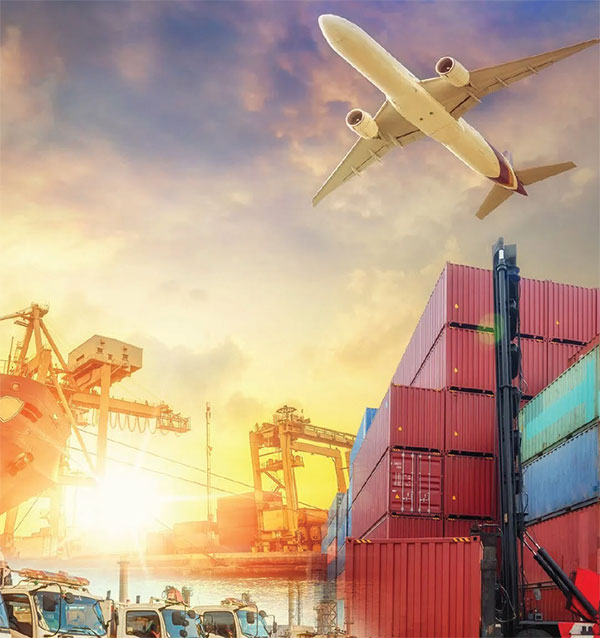 In the Middle East, the logistics industry is experiencing significant growth and transformation driven by numerous factors, including economic development, infrastructure investments, technological advancements, and changing consumer behaviour. Here are some of the latest trends shaping the logistics business in the region
In the Middle East, the logistics industry is experiencing significant growth and transformation driven by numerous factors, including economic development, infrastructure investments, technological advancements, and changing consumer behaviour. Here are some of the latest trends shaping the logistics business in the region
Infrastructure Development: The Middle East is witnessing substantial investments in infrastructure projects, including the development of ports, airports, roads, and rail networks, leading to enhanced connectivity and logistics capabilities.
E-commerce Growth: The rise of e-commerce is reshaping the logistics landscape in the Middle East, with increasing consumer demand for fast and convenient delivery services. As more consumers turn to online shopping, logistics companies are investing in last-mile delivery solutions, warehouse automation, and technology-enabled logistics platforms to meet growing demand and improve service levels.
Digitalization and Technology Adoption: Digitalization is driving efficiency and innovation across the logistics industry in the Middle East. Companies are leveraging technologies such as artificial intelligence, blockchain, Internet of Things (IoT), and big data analytics to optimize supply chain processes, improve visibility, and enhance decision-making. Digital platforms and marketplaces are also facilitating seamless collaboration and communication between stakeholders in the logistics ecosystem.
Sustainability Initiatives: Sustainability has become a key focus area for logistics companies in the Middle East, driven by environmental concerns and regulatory requirements. Companies are implementing green logistics practices, such as the use of alternative fuels, electric vehicles, and sustainable packaging, to reduce carbon emissions and minimize environmental impact. Additionally, there is a growing emphasis on supply chain transparency and responsible sourcing to meet consumer expectations for ethical and sustainable products.
Cross-Border Trade and Logistics Hubs: The Middle East’s strategic geographic location makes it an important hub for global trade and logistics activities. Countries such as the United Arab Emirates (UAE), Saudi Arabia, and Qatar are investing in logistics infrastructure and developing logistics hubs to facilitate cross-border trade and transit shipments. These hubs serve as vital gateways connecting markets in Asia, Europe, Africa, and beyond, attracting multinational companies and fostering economic growth.

Regulatory Reforms: Governments in the Middle East are implementing regulatory reforms to enhance the competitiveness of the logistics sector and attract foreign investment. Initiatives such as customs modernization, trade facilitation measures, and investment incentives aim to streamline logistics processes, reduce costs, and improve efficiency. Additionally, the adoption of technology-driven solutions, such as electronic documentation and customs clearance systems, is simplifying trade procedures and accelerating cross-border movement of goods.
Oil and Gas Industry: The oil and gas sector remain a significant driver of logistics activity in the Middle East, with large volumes of petroleum products, chemicals, and related goods being transported within and outside the region. Logistics providers catering to the energy industry play a vital role in supporting upstream, midstream, and downstream operations.
Global Trade Dynamics: Political and economic factors, as well as international trade agreements and sanctions, impact the volume of logistics activity in the Middle East region. Changes in trade policies, currency fluctuations, and geopolitical tensions can influence shipping routes, trade volumes, and logistics patterns.
The Middle East is home to several major sea and airports that serve as vital hubs for trade and transportation within the region and beyond. Here are some notable seas and airport infrastructures in the Middle East:
 Sea Ports: Jebel Ali Port, Dubai, UAE : Jebel Ali Port is one of the largest container ports in the world, serving as a key maritime gateway for trade between the East and the West. The port complex includes container terminals, general cargo facilities, and a free trade zone, facilitating diverse cargo handling operations. Jebel Ali Port is strategically located near major shipping routes, offering efficient connectivity to global markets.
Sea Ports: Jebel Ali Port, Dubai, UAE : Jebel Ali Port is one of the largest container ports in the world, serving as a key maritime gateway for trade between the East and the West. The port complex includes container terminals, general cargo facilities, and a free trade zone, facilitating diverse cargo handling operations. Jebel Ali Port is strategically located near major shipping routes, offering efficient connectivity to global markets.
Port of Salalah, Oman: Situated on the Arabian Sea coast, the Port of Salalah is a major transshipment hub in the Middle East, serving as a crucial link between Asia, Africa, and Europe. The port features state-of-the-art container terminals, bulk cargo facilities, and a free zone, offering comprehensive logistics services to international trade partners. Port expansion projects have enhanced its capacity and capabilities, positioning it as a competitive player in the global maritime industry.
King Abdullah Port, Saudi Arabia: Located on the Red Sea coast, King Abdullah Port is a modern, multi-purpose maritime facility designed to accommodate diverse cargo types, including containers, bulk, and general cargo. The port’s strategic location along the Red Sea trade route offers direct access to key markets in Europe, Asia, and Africa, facilitating efficient trade flows. With advanced infrastructure and technology, King Abdullah Port aims to become a leading logistics hub in the region, supporting Saudi Arabia’s economic diversification efforts.
Airports: Dubai International Airport, UAE : Dubai International Airport is one of the busiest airports in the world, serving as a major aviation hub for passenger and cargo traffic. The airport’s cargo facilities, including dedicated cargo terminals and freighter operations, manage a significant volume of air cargo shipments, connecting Dubai to global markets. Plans for expansion and the development of Dubai South, including the Al Maktoum International Airport, aim to further enhance Dubai’s air cargo capabilities and position the emirate as a leading logistics hub.
Hamad International Airport, Qatar: Hamad International Airport serves as Qatar’s primary aviation gateway and a key hub for air cargo operations in the Middle East. The airport’s state-of-the-art cargo terminal features advanced handling facilities, temperature-controlled storage, and specialized handling capabilities for perishable goods, pharmaceuticals, and other high-value cargo. With its strategic location and modern infrastructure, Hamad International Airport plays a vital role in facilitating Qatar’s trade links with global markets.
King Fahd International Airport, Saudi Arabia: King Fahd International Airport, located in Dammam, is one of the largest airports in the world in terms of land area and serves as a key aviation hub in Saudi Arabia’s Eastern Province. The airport’s cargo facilities include dedicated cargo terminals and specialized handling services, supporting the region’s industrial and commercial activities. With ongoing investments in infrastructure and expansion projects, King Fahd International Airport aims to enhance its capacity and capabilities to meet growing demand for air cargo services in the region.
The logistics industry in the Middle East is undergoing rapid evolution, driven by a combination of infrastructure development, technological innovation, and changing market dynamics. By embracing these trends and leveraging opportunities for growth and optimization, logistics companies can position themselves for success in this dynamic and fast-growing region.